This page is The Museum's Collection.
The Museum's Collection
In the stories archaeology tells us, the main characters are archaeological and historical resources unearthed from the ground, such as unglazed earthenware, stone implements, and the remains of ancient dwellings, tumuli (burial mounds), and kilns. But they are not alone: you, the viewer, are also a star of the story. It is when you and archaeological materials encounter one another that mysteries begin to be solved. Touch, try, feel, think and investigate. Experience the distant past of Hyogo, never presented in this way at an archaeological museum before!
Entrance Gallery: A panorama of 3,500 years
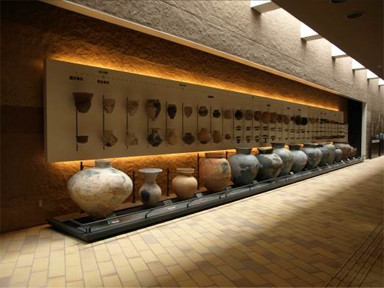
Upon entering the gallery, you are greeted by earthenware pottery excavated from ancient soil layers and restored. Through the evolving styles of pottery, you can visualize the great arc of 3,500 years of history, from the Jomon period (14,000–300 BC) to the Edo period (1603–1868 AD).
Dig up ruins and be an archaeologist yourself!
Hands-on Gallery Discovery Room

Surely the most exciting thing about archaeology is unearthing new discoveries. We brought the ruins of an entire dwelling here, and recreated the site where it was excavated.
There are many fun exhibitions where you can experience excavation and encounter the mysteries of history. Dig into the ancient ruins buried right at your feet!
Excavate!
We transported the 1,900-year-old remains of a pit dwelling house from the Yayoi Period (300 BC–250 AD), found at the nearby Onaka Ruins, to the hall just as it is, and recreated the excavation site. In this exciting discovery zone, the hands-on excavation program is the most popular attraction. Experience the joy of discovery!
Investigate!
What can we learn from ancient ruins and artifacts? In this zone where you unravel history’s mysteries, hints are hidden in doors and drawers. Imagine and think about the lives of people in ancient times.
The romance of times past, actual size!
Thematic Exhibition Hall
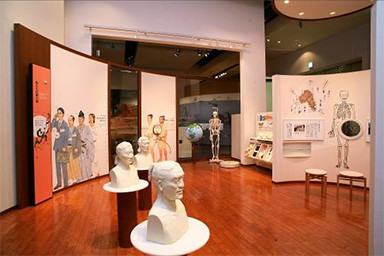
Explore the history of Hyogo through the four themes of People, Environment, Society, and Interaction. Archaeological materials excavated from ruins in the prefecture, and models and images based on the latest research findings, will stimulate your imagination and take you on a wondrous journey across time and space.
Theme I : People Our Origins
What kind of people lived in ancient Hyogo? We have replicated the figures of ancient people from human bones found at various ruins around the prefecture, such as the Akashi Skeletons, which are still shrouded in mystery. While comparing them with how people look today, take a moment to think about our origins and where our ancestors came from.
The Ancestors of Hyogo’s People
Jomon people, Yayoi people, Kofun people: here we exhibit the remains of people who inhabited Hyogo in the distant past. Try to imagine our ancestors, what their faces looked like, and how they lived.
The Mystery of Nipponantropus akashiensis
Trace the tale of Nipponantropus akashiensis, commonly known as “the Akashi hominid,” from the first discovery of human bones in Akashi to the present day. Who was “Akashi man”? The riddle remains unsolved…
Evolution of Human Beings and the Origin of the Japanese
This exhibit looks back over the long path from the emergence of humankind to today. How will we, the human race, change going into the future?
Theme II : Environment Living Amid Nature

Human beings live by the grace of nature, and are sometimes threatened by its fury. Here, we recreate the living conditions of ancient people surviving amid nature, such as a prehistoric Naumann elephant hunters’ camp, a Jomon village fortuitously located near mountains and the sea, and a Yayoi farm village where people plowed the earth and battled floods. Consider history from the perspective of relationships between the natural environment and human beings.
Elephant Hunters of the Paleolithic: 30,000 years ago
This exhibit recreates a camp of hunters of the Naumann elephant (a prehistoric elephant that once roamed southern Japan). The sight of people bravely confronting the mighty power of nature is inspiring.
Naturalists of the Neolithic: Jomon Period (3,500 years ago)
This exhibit recreates the lifestyles of Jomon people, who lived in a bounteous environment and benefited from nature’s blessings. The wisdom of ancient people who maximized the gifts of nature still has much to teach us today.
Pioneers of Rice Cultivation: Yayoi Period (2,100 years ago)
This exhibit recreates a community of Yayoi people, who tilled the earth, built rice paddies, fought frequent floods, and prayed for rich harvests. The power and technical prowess of the Yayoi people, who sought to master and modify the natural environment, is something to behold.
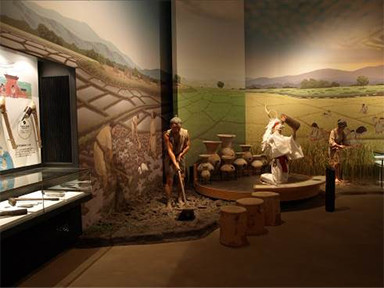
Theme III : Society Birth of the Nation
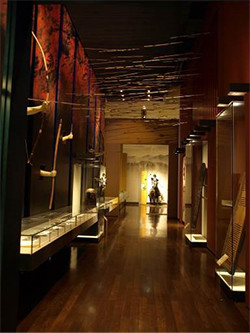
People fought, destroyed, and reconstructed, and from this chaos society emerged. As the inhabitants of the Japanese islands battled one another over and over, they gradually developed rules for living peacefully together. Here we trace the long journey toward building a nation, through weapons of war, tombs of kings, and the administrative institutions of the ancients.
People at War: Yayoi Period–Kofun Period (2,100–1,600 years ago)
The lethal implements that appeared during the Yayoi era grew more powerful as battles became ever fiercer. Weapons from the Kofun and Yayoi periods paint a picture of wars of the distant past.
From Village to Country: Yayoi Period–Kofun Period (2,100–1,800 years ago)
Through fighting side by side, people banded together in small villages, and eventually a nation emerged. Here, the remains of those fallen in battle and the graves of rulers illustrate changes in society from the Yayoi Period through the Kofun Period.
Symbols of Power: Kofun Period (1,600 years ago)
This exhibit conveys the magnitude of the power of Kofun Period kings with a reconstructed model of the stone chamber at Kumobe Kurumazuka Kofun (Tumulus), a royal tomb in Tamba, Hyogo.

The Beginning of the Ritsuryo State: Nara Period (1,300 years ago)
This section conveys what the Japanese nation was like under the ritsuryo codes, through administrative sites, way stations, and ritual implements. In the mini-theater, you can view a historical picture scroll showing the transition from the Kofun Period to the Nara Period.
Theme IV : Interaction Meeting and Moving in Ancient Times

Hyogo has been a land and sea transport hub since ancient times, where many people’s paths crossed and new culture arose. In this section, the interweaving flow of people and things in Hyogo is conveyed with exhibits such as a restored ancient ship that traveled back and forth between the Asian continent and Tamba, Hyogo, and the sarcophagus of a mighty king.
Trade in Regional Specialties: Jomon Period–Kofun Period (3,500–1,600 years ago)
Here are exhibited items whose paths led from various parts of the Japanese islands to Hyogo. They include the restored sarcophagus of a great king, made from Tatsuyama stone, from the Kofun Period.
An Ancient Ship Reborn: Kofun Period (1,800–1,500 years ago)
Based on a line drawing engraved in wood at the ruins of Tajima showing a fleet from the Kofun Period, we have recreated an ancient ship at full scale. It vividly illustrates what sea travel to and from the Asian continent must have been like in those days.
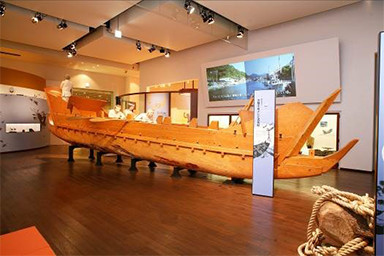
Birth of the Hyogo Brand: Heian Period–Kamakura Period (800 years ago)
From the Heian Period through the Kamakura Period, Hyogo Prefecture was a major center for the production of pottery. Here, Sue ware and roof tiles are exhibited as examples of “brand-name” Hyogo products that enjoyed popularity throughout Japan.
Bustling Town, Prosperous Port: Heian Period–Kamakura Period (800 years ago)
By the end of the Heian Period, trade with the Song Dynasty (960–1279) in China was underway at Owada no Tomari, the predecessor of the present-day port of Kobe. This exhibit shows the vibrant movement of people and things, through the remains of the medieval port and town.
Connecting to the Wider World: Muromachi Period–Meiji Period (500–100 years ago)
Times changed, and trade and exchange with overseas countries grew. Here, interaction with China and Europe is embodied by familiar goods such as tea, tobacco and tiles.
Exhibits from the Collection
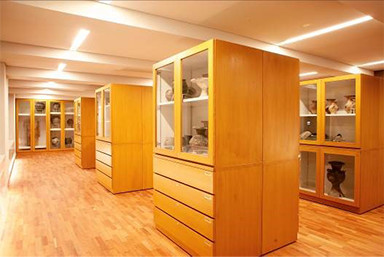
In the display cases installed on the backyard tour deck, you can take a close look at archaeological materials in the museum’s collection. These materials consist of pottery and stoneware that serve as vital cornerstones of Yayoi- to Meiji-era archaeological research in Hyogo Prefecture.
Outdoor Exhibit: Reconstructed Ancient Yayoi Village in Onaka, Harima
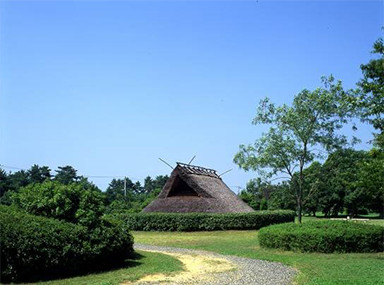
The Onaka ruins are remnants of a village that existed from the early Kofun to the late Yayoi Period (1,900–1,800 years ago). They were discovered by a local junior high school student in 1962, and were designated as a national Historic Site in 1967 following the discovery of various styles of pit dwelling houses and the excavation of Chinese mirrors. The museum has created this environment by restoring pit dwellings with the help of local volunteers, and the “Reconstructed Ancient Yayoi Village in Onaka, Harima” is open to the public as an outdoor museum exhibit.

